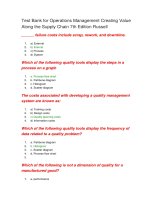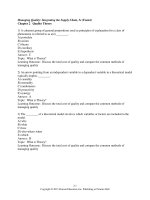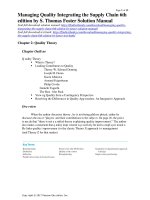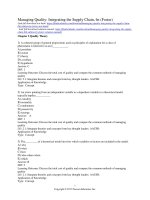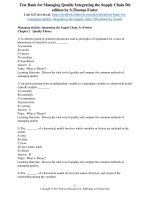Lecture Operations management: Creating value along the supply chain (Canadian edition) - Chapter 3
Bạn đang xem bản rút gọn của tài liệu. Xem và tải ngay bản đầy đủ của tài liệu tại đây (879.57 KB, 56 trang )
OPERATIONS MANAGEMENT:
Creating Value Along the Supply Chain,
Canadian Edition
Robert S. Russell, Bernard W. Taylor III, Ignacio Castillo, Navneet Vidyarthi
CHAPTER 3
Statistical Process Control
1
Learning Objectives
Explain the basics of applying statistical process control
(SPC) in production and services.
Discuss the rationale and procedure for the initial
construction of a control chart.
Use attribute control charts.
Use variable control charts.
Identify control chart patterns and describe appropriate data
collection.
Evaluate the process capability of a process.
3-2
Lecture Outline
Basics of Statistical Process Control
Control Charts
Control Charts for Attributes
Control Charts for Variables
Control Chart Patterns
SPC with Excel and OM Tools
Process Capability
3-3
Statistical Process Control (SPC)
Statistical Process Control
monitoring production process to detect and prevent poor quality
Sample
subset of items produced to use for inspection
Control Charts
process is within statistical control limits
UCL
LCL
3-4
Process Variability
Random
• inherent in a process
• depends on equipment
and machinery,
engineering, operator,
and system of
measurement
• natural occurrences
Non-Random
• special causes
• identifiable and correctable
• include equipment out of
adjustment, defective
materials, changes in parts
or materials, broken
machinery or equipment,
operator fatigue or poor
work methods, or errors
due to lack of training
3-5
SPC in Quality Management
SPC uses
Is the process in control?
Identify problems in order to make improvements
Contribute to the TQM goal of continuous improvement
3-6
Quality Measures:
Attributes and Variables
Attribute
A characteristic which is evaluated with a discrete
response
good/bad; yes/no; correct/incorrect
Variable measure
A characteristic that is continuous and can be measured
Weight, length, voltage, volume
3-7
SPC Applied to Services
Nature of defects is different in services
Service defect is a failure to meet customer
requirements
Monitor time and customer satisfaction
3-8
SPC Applied to Services
Hospitals
timeliness & quickness of care, staff responses to requests, accuracy
of lab tests, cleanliness, courtesy, accuracy of paperwork, speed of
admittance & checkouts
Grocery stores
waiting time to check out, frequency of out-of-stock items, quality of
food items, cleanliness, customer complaints, checkout register
errors
Airlines
flight delays, lost luggage & luggage handling, waiting time at ticket
counters & check-in, agent & flight attendant courtesy, accurate flight
information, cabin cleanliness & maintenance
3-9
SPC Applied to Services
Fast-food restaurants
waiting time for service, customer complaints, cleanliness, food
quality, order accuracy, employee courtesy
Catalogue-order companies
order accuracy, operator knowledge & courtesy, packaging, delivery
time, phone order waiting time
Insurance companies
billing accuracy, timeliness of claims processing, agent availability &
response time
3-10
Where to Use Control Charts
Process
Has a tendency to go out of control
Is particularly harmful and costly if it goes out of control
Examples
At beginning of process because of waste to begin
production process with bad supplies
Before a costly or irreversible point, after which product is
difficult to rework or correct
Before and after assembly or painting operations that
might cover defects
Before the outgoing final product or service is delivered
3-11
Control Charts
A graph that monitors process quality
Control limits
upper and lower bands of a control chart
Attributes chart
•
•
p-chart
c-chart
Variables chart
•
mean (x bar – chart)
•
range (R-chart)
3-12
Process Control Chart
3-13
Normal Distribution
Probabilities for Z= 2.00 and Z = 3.00
3-14
A Process Is in Control If …
1.
2.
3.
4.
… no sample points outside limits
… most points near process average
… about equal number of points above
and below centerline
… points appear randomly distributed
3-15
Control Charts for Attributes
p-chart
uses portion defective in a sample
c-chart
uses number of defects (non-conformities) in a sample
3-16
p-Chart
UCL = p + z p
LCL = p - z p
z
p
= number of standard deviations from process average
= sample proportion defective; estimates process mean
p = standard deviation of sample proportion
p=
p(1 - p)
n
3-17
Construction of p-Chart
3-18
Construction of p-Chart
p=
total defectives
total sample observations
UCL = p + z
= 200 / 20(100) = 0.10
p(1 - p)
= 0.10 + 3
n
0.10(1 - 0.10)
100
UCL = 0.190
LCL = p - z
p(1 - p)
= 0.10 - 3
n
0.10(1 - 0.10)
100
LCL = 0.010
3-19
Construction of p-Chart
3-20
p-Chart in Excel
Click on “Insert” then
“Charts”
to construct control chart
I4 + 3*SQRT(I4*(1-I4)/100)
I4 - 3*SQRT(I4*(1-I4)/100)
Column values
copied
from I5 and I6
3-21
c-Chart
UCL = c + z c
LCL = c - z c
c=
c
where
c = number of defects per sample
3-22
c-Chart
Number of defects in 15 sample rooms
NUMBER
SAMPLE OF
DEFECTS
1
2
3
:
:
15
12
8
16
190
c = 15
= 12.67
UCL
:
:
15
190
LCL
=c+z c
= 12.67 + 3
= 23.35
12.67
=c-z c
= 12.67 - 3
= 1.99
12.67
3-23
c-Chart
3-24
Control Charts for Variables
§
Range chart ( R-Chart )
§
§
Plot sample range (variability)
Mean chart ( x -Chart )
§
Plot sample averages
3-25


